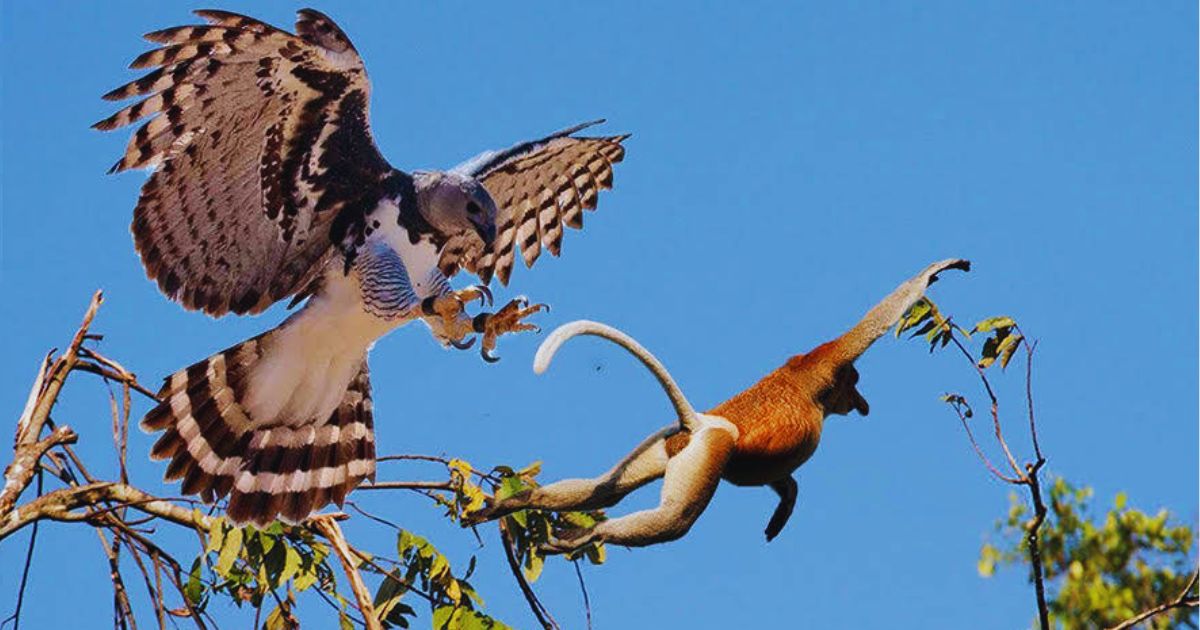The Amazon rainforest is home to many incredible creatures, but few are as awe-inspiring as the Harpy Eagle. With a wingspan of 6.5 feet and talons the size of a bear’s claw, this majestic bird is a predator of epic proportions. However, the harpy eagle is now facing the threat of extinction due to habitat loss caused by deforestation.
The Harpy Eagle Is a Fearful Hunter
The harpy eagle, also known as Harpia harpyja, is instantly recognizable by its mighty feather crown that rises when the bird is alarmed, resembling scarier and larger versions of owls. Despite their intimidating appearance, these birds are raptors, meaning they are birds of prey capable of devouring animals comparable in size to themselves.

The harpy eagle earned its name from the harpies of Greek mythology, fearsome hybrid creatures with the body of a bird and the face of a man. The bird was first described by Swedish botanist Carl Linnaeus in 1758, who named it Vultur harpyja in his book Systema Naturae.
These magnificent birds are native to Latin America, ranging from Mexico to northern Argentina, and are particularly prevalent in Panama, where they are considered the national bird. With their black, grey, and white plumage, they are not only visually striking but also one of the largest eagle species in the world. Females are significantly larger, weighing between 13 to 20 pounds, while males reach a maximum weight of around 12 pounds.
The harpy eagle boasts a wingspan of up to 6.5 feet, allowing it to expertly maneuver through the forest at speeds of up to 50 miles per hour. Unlike other eagle species, the harpy prefers flying at mid-level rather than soaring high above the treetops. Its talons, measuring five inches in length, are the largest among all eagle species.
These silent hunters usually ambush their prey and have a particular fondness for small mammals. The larger females have been known to hunt sloths and monkeys, easily swooping down to pick them up thanks to their strength and agility.
Captive Breeding: A Beacon of Hope
Harpy eagles are monogamous, forming lifelong partnerships. However, they are slow breeders, with females laying only a couple of eggs every two to three years. Typically, only the first offspring to hatch survives into adulthood, as it receives the most attention from its parents. Harpy eagle hatchlings are born white and gradually acquire their dark coloring as they mature.

Given their declining population, breeding harpy eagles in captivity has become a vital effort in preserving their survival. Since 1992, when the first successful breeding and raising of a harpy eaglet occurred in North America, various conservation organizations have made significant progress. The San Diego Zoo, for example, successfully bred a pair of harpy eagles brought from Germany and Colombia.
One such center dedicated to harpy eagle reproduction is the Bela Vista Biological Refuge in Brazil, where the 50th harpy eaglet was born in May 2020. These breeding programs provide hope for the future of this remarkable species. Despite being formidable predators, harpy eagles are now facing a concerning future. According to the Union for Conservation of Nature’s Red List of Threatened Species, the harpy eagle is classified as “near threatened.” This classification is particularly distressing because harpy eagles are apex predators, playing a vital role in maintaining the balance of the ecosystem.
Despite being formidable predators, harpy eagles are now facing a concerning future. According to the Union for Conservation of Nature’s Red List of Threatened Species, the harpy eagle is classified as “near threatened.” This classification is particularly distressing because harpy eagles are apex predators, playing a vital role in maintaining the balance of the ecosystem.
Regrettably, the harpy eagle’s population has significantly declined due to deforestation in its known habitats throughout South America. Approximately 93% of their habitat now lies within the Amazon, where rampant deforestation has left them vulnerable. These birds are not migratory, meaning they cannot adapt to different environments, making habitat preservation even more critical.
To combat this decline, conservation organizations like the Peregrine Fund are working to identify harpy eagle habitats and establish protective perimeters. Collaboration with local biologists and educational campaigns about the species, such as those led by Everton Miranda, have also proven invaluable.

Conservation efforts and captive breeding programs have shown promise, but there is still much work to be done to ensure the harpy eagle’s survival. These magnificent birds deserve a fighting chance, even though they may seem like creatures straight out of Greek mythology.
To learn more about fascinating extinct bird species, read about Haast’s eagle, New Zealand’s giant bird that went extinct 600 years ago. Additionally, discover the kakapo, the unique flightless “owl parrot” of New Zealand.
Harpy eagles are apex predators which means their well-being greatly affe
Remember to stay up to date with vintage news and explore more captivating stories on All Vintage News, the go-to source for all things vintage.






